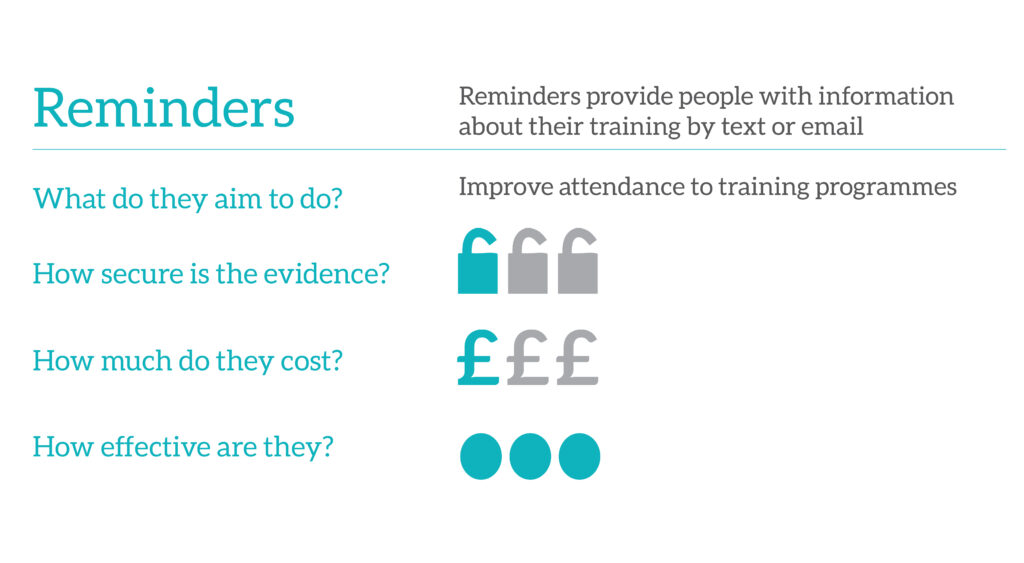
What are they and what do they aim to do?
Reminders provide people with information about available training or forthcoming courses for which they are enrolled. For example, they may remind people about their timetable for the coming week. Reminders may be important because individuals juggle tasks to reach competing objectives and things like training courses may be easily neglected. Sending individuals reminders by text message or email is a very cheap way to potentially increase attendance for training programmes.
How effective are they?
We found one study of text reminders for an employment training programme. This study finds positive impacts on course attendance and final exam performance.
This finding is supported by two out of three studies of mail and text reminders aimed at increasing school attendance. These studies examine the impact of providing regular information about absences to parents with two studies finding positive effects and one study finding no effect.
These positive findings are repeated in several other contexts, for example, for weekly email reminders sent to gym members to attend, for low income households in the U.S. reminded (by email) to claim a tax credit, for voters in the U.S. reminded (by text) to vote, for patients in Saudi Arabia reminded (by text) to attend their hospital appointments, and for households in Bolivia, Peru and the Philippines reminded (by text) to save.
How secure is the evidence?
We found one study on the impact of reminders for employment training, three programmes aimed at reducing school absenteeism and five on the impact of reminders in other contexts.
While limited in number, the studies are of high quality — all nine are randomised control trials (RCTs). The evidence also mostly relates to relevant countries — the employment training study is from the UK, and three of the five from other contexts are from the OECD.
Nevertheless, more studies on the impact of reminders in the area of employment training are needed. RCT designs for reminders are easy to set up and low cost.
For a full list of studies and summaries of their findings see the PDF document below.
Are they cost-effective?
Reminders are very low cost and the evidence suggests they can be cost-effective.
Studies that compare the effects of text and telephone reminders show they are equally effective. However, text is cheaper both in terms of administration and telephone company fees, plus they can be scheduled to be sent at the most relevant times. Emails are cheaper still, and can provide more content and information than a text message. However, emails may not reach everyone, especially those on lower incomes who may not have easy, or any, internet access.
Overall, in most existing applications reminders appear to be a very cost effective policy design feature.
Things to consider
- Reminders that improve training attendance may also have positive effects on performance, as measured by final grades.
- The notice should be as simple as possible and should highlight the benefits.
- Trialling different wording may be a simple way to increases response rates. In our examples, emphasising the size of potential benefits or reminding the individual of their personal motivation for the activity improved effectiveness. In contrast, the tone of the message (warm/personal vs cold/impersonal) and information on time for compliance, made no difference to effectiveness.
- For training programmes aimed at the unemployed, it may be that text has a wider reach than email.
- Reminders are often more effective for those least likely to attend.
- Individuals tend to respond quickly to reminders. Therefore, reminders could be used to regulate peak and off-peak times for certain activities by sending them during quiet periods.





